
|
Sale 17
Coin Auction
| Lot |
Photo |
Description |
Realized |
Lot 1 |
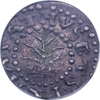 |
Massachusetts Oak Tree Twopence 1662, N-31, Cr-1-A3, R-6. 8.6 grains. PCGS graded AU-53. This coin was struck on a nicely round, but rough planchet. Toned a medium gray color, and well balanced. The date is weak on the reverse due to the die state, which shows the expected crack at the top of the 2 to the A in ENGLAND. On balance, the coin is well struck, but trace weakness can be found on some letters and on the lower portion of the oak tree. Rare and seldom offered, the Twopence is desired by type and variety specialists. Struck on a light planchet, but still within the expected range for these. The surfaces are without handling problems, aside from the roughness noted in the fields. The exact die state is difficult to determine because of the roughness. PCGS has graded 8 as such, with just 10 graded higher.
Estimated Value $4,000 - 5,000.
From the Paul Arthur Norris Collection.
View details and enlarged photos
| Realized
$3,680 |
Lot 2 |
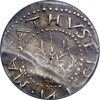 |
Massachusetts Oak Tree Sixpence 1652, N-20, Cr. 1a-D. PCGS graded EF-45. Antique silvery gray in color with the familiar "S" shaped bend from the rocker press on which they were struck, on this particular one the crease is through the lower left of the obverse. The planchet is slightly elongated being taller than it is wide. Well struck and with very nice surfaces for the issue. One thin line is noted on the upper right of the tree and this may be remnants of an undertype or possibly a minor split in the planchet.
The source of the silver for these early coins was Spanish coinage, which had enriched Spain for several generations. The Spanish silver was melted down and purified up to acceptable levels for sterling, then rolled into strips for planchets. These 1652 coins represent some of the most important and collectible of the entire spectrum of colonial coinage.
Estimated Value $3,000 - 4,000.
From the Paul Arthur Norris Collection.
View details and enlarged photos
| Realized
$4,025 |
Lot 3 |
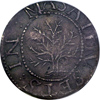 |
Massachusetts Oak Tree Shilling 1652, Noe 1, Crosby 9-H. 70.4 grains. PCGS graded EF-45. An important example of this rare issue which boasts a clean planchet and well struck devices. The surfaces show scattered handling including some ancient pin scratches on the upper right of the obverse, and another scrape on the reverse on the L of ENGLAND. Pleasing antique silver toning on both sides adds to the appeal. The planchet is fairly round, and the strike is well centered with only the tops of a few of the peripheral letters run to the edge.
Thought to have been the first of the oak trees struck on the rocker dies, these are usually found with well rounded planchets and much better than average strikes, as seen here. As a type coin, this example would make an ideal purchase, as many other varieties are not only much rarer and more costly, but tend to come with more challenging planchets and weaker strikes. An impressive coin for the colonial specialist.
Estimated Value $5,000 - 6,000.
From the Paul Arthur Norris Collection.
View details and enlarged photos
| Realized
$4,140 |
Lot 4 |
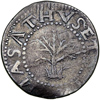 |
Massachusetts 1652 Oak Tree Shilling, N-13.6, R-6. VF-30. Nicely struck with only a few minor areas of weakness near the rim on the obverse, as usual. The color is a pleasing antique silvery gray, and the surfaces show minimal signs of handling. A rare variety for the specialist.
Estimated Value $3,000 - 4,000.
View details and enlarged photos
| Unsold |
Lot 5 |
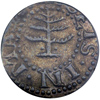 |
Massachusetts Pine Tree Sixpence 1652. 32.1 grains. PCGS graded AU-50. Steel gray in color with some hints of gold near the lettering and devices. The lower right obverse is sharp, while the upper left obverse is weak on some of the lettering, which is slightly off center. As to the surfaces, we note the usual trivial ticks and handling marks from brief circulation, and a small rim distrubance on the lower right obverse. The reverse boasts a well centered and balanced strike, with all lettering clear to the unaided eye. We note a disturbance on the D of ENGLAND and above to the rim, and this is probably related to the obverse nick. For the grade, this is a very acceptable coin and few have been located that are appreciably better. PCGS reports just 2 mint state coins, plus 6 in higher AU grades than offered here. A desirable example of this scarce and popular issue.
Estimated Value $4,000 - 5,000.
From the Paul Arthur Norris Collection.
View details and enlarged photos
| Realized
$4,485 |
Lot 6 |
 |
Massachusetts 1652 Pine Tree Shilling. Small planchet. PCGS graded EF-45 72.4 grs. Struck on a slightly porous planchet with plenty of detail clearly visible. Mottled areas of dark gray and violet appear on both sides. This popular coin will be cherished for its strong and well centered obverse (PCGS # 24) .
Estimated Value $4,500 - 5,000.
View details and enlarged photos
Check results on similar lots
| Unsold |
Lot 7 |
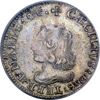 |
Maryland Sixpence, Lord Baltimore. Dies 2-C, R-5. PCGS graded AU-58. One of the finest graded of this rare coin, it stands alone as the sole "58" seen by PCGS and we note a single coin graded higher as MS-61 out of a grand total of 12 graded in all of the sixpence denomination. The surfaces are toned a lovely light antique silver color with darker gold flecks around the obverse periphery, and similar on the reverse with more gold toning over silver gray color located on that side. Weakly struck on the central obverse but all the device outlines are present. One very minor mark is noted on face, from the back of the nose to the hair, but a strong glass is needed to find it. No other surface problems worthy of note and this coin is far above average in surface quality, even for this grade.
Die information from the Bowers & Merena Norweb catalog, November 15, 1988, page 233, which should be seen for further information.
Estimated Value $12,500-UP.
From the Paul Arthur Norris Collection.
View details and enlarged photos
| Realized
$10,925 |
Lot 8 |
 |
Maryland Shilling, Lord Baltimore. Dies 1-A, R-6. PCGS graded AU-55. One of the classic rarities of the Colonial issues, the Lord Baltimore shilling elicits collector excitement whenever they are offered. On this particular specimen we note the planchet is of good quality, and the color is a natural lilac silvery gray. The strike is typical for the issue, with the weakness in the hair on Lord Calvert, and the familiar die injury (clashing?) on the reverse below II in the denomination. Close scrutiny will note a thin line like mark from the lower rim into the bust of Lord Baltimore, and a similar and thinner line from the rim into the D of DNS, and we suspect that this coin may have been struck three or more times, the first two strikes off-center, with these trace lines (from the edge of the previous off center-strikes) remaining as evidence. Corresponding planchet lines are present on the reverse. A great rarity, and we note that PCGS has graded only 3 of these Lord Baltimore shillings as AU-55, with 1 higher as AU-58 and one at the top at MS-61 out of a grand total of 24 graded in all grades listed. Breen estimates the entire mintage at 20,000 pieces, virtually all of which have long since disappeared. They were struck in London, probably at the Tower Mint.
Early silver in the American colonies is quite rare, most coinages were of copper by the various states and other cast offs from England, Ireland and France. Here is one of the finest of these rare and desirable Lord Baltimore shillings to survive. Better than the examples offered in Picker, Robison, Eliasberg or Roper. An opportunity of great importance for the colonial specialist.
Estimated Value $15,000-UP.
From the Paul Arthur Norris Collection.
View details and enlarged photos
| Realized
$12,075 |
Lot 9 |
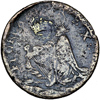 |
New Jersey. St. Patrick Copper Farthing. Sharpness of VG-8 but porous. This one is pretty banged up, but easily identifiable. Some rim bumps as well and generally porous on both sides.
Estimated Value $100 - 125.
View details and enlarged photos
| Realized
$288 |
Lot 10 |
|
1723 Wood's Hibernia Farthing. "DEI GRATIA REX". PCGS graded EF-40. Pleasing medium brown with some lighter highlights (PCGS # 176) .
Estimated Value $200 - 240.
View details
Check results on similar lots
| Realized
$196 |
Lot 11 |
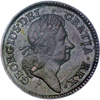 |
1723 Wood's Hibernia Halfpenny. PCGS graded AU-58. Medium brown in color and pleasing in appearance. A glass will note a minor planchet streak which appears in minute irregular dashes from rim to rim through the truncation to the first A in GRATIA. A couple of very minor toning flecks are noted on both sides. Boldly struck by the dies, and we note just minor friction on the high points. Perfectly balanced for the grade (PCGS # 180) .
Estimated Value $400 - 500.
View details and enlarged photos
Check results on similar lots
| Unsold |
Lot 12 |
|
1773 Virginia Halfpenny. Sharpness of Very Fine but porous. The surfaces are corroded and pitted on both sides, but most of the device detail remains.
Estimated Value $80 - 100.
View details
| Realized
$69 |
Lot 13 |
|
1773 Virginia Halfpenny. Period after "GEORGIVS". PCGS graded AU-58. Well struck from slightly rusted dies with the surfaces still retaining some reflective qualities. Attractive light iridescent toning adds to its appeal (PCGS # 240) .
Estimated Value $400 - 500.
View details
Check results on similar lots
| Unsold |
Lot 14 |
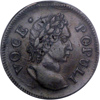 |
1760 Voce Populi Halfpenny. PCGS graded AU-55. A pleasing problem-free example exhibiting glossy reddish brown surfaces on both sides (PCGS # 262) .
Estimated Value $800 - 900.
View details and enlarged photos
Check results on similar lots
| Realized
$920 |
Lot 15 |
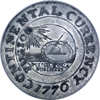 |
1776 Continental Currency - "Pewter" (Tin), inscribed "CURRENCY" Newman 2-C. PCGS graded MS-61 Currency, Pewter. Light steel gray in color with the obverse very clean for the grade, on the reverse the color is also well matched, and we note a couple of trivial marks on some of the chain links. As expected, the strike is sharp throughout, with no weakness whatsoever. There are scattered lumps of tin pesting on both sides, but primarily on the reverse, as often seen on coins of this metallic content. For more than the last century, these were thought to have been struck in pewter, but they are actually tin, although similar, not quite the same alloys. Keeping with this numismatic tradition, PCGS notes on their insert "Pewter". PCGS has graded only one as such, with a dozen graded higher. Most are found in circulated grades.
The American Continental Congress anticipated a loan of silver for coinage from their friends in France, and hence unknown intermediaries contacted New Jersey engraver Elisha Gallaudet to make dies, employing his popular renderings of the sundial and chain with each state engraved one to a link. Coinage began in secret, pending the hoped for loan of silver from France, these were struck primarily in tin, a few in brass, copper and even a silver example or two are known. As a new nation, the United States needed to exercise its sovereign right to coin money, and further it was hoped that these coins would help prop up the rapidly deflating Continental Currency then in circulation. In theory, the Continental notes would then be redeemable in silver coin, supporting the notes stated value.
Many tin coins circulated, and their popularity remains high with the date 1776 emblazoned on the obverse, and the strong chain of the 13 original colonies linked on the reverse, with the bold statement WE ARE ONE at the center. The design elements had been sketched by Benjamin Franklin, and were seen on a few Continental currency notes attributed to Elisha Gallaudet by Eric Newman (see the Continental Currency chapter, issue of February 17, 1776 Resolution fractional notes). These notes were clearly copied for the coin herein, and misspellings of "currencey" are seen on both the notes as well as a few of the coins!
The true denomination is not known, although they are approximately the size of later dollars, and hence that name has stuck. Perhaps they were meant to be Pence, or something closer to a cent in circulating value when struck in tin. Highly popular with collectors, the design elements employ the medieval symbols of the Sun with Face (God or Time personified), while the sundial with FUGIO refers to Time or the Sun which is fleeing, so one must use Time or daylight hours, wisely. The motto, MIND YOUR BUSINESS means just that. On the reverse, each state is noted or abbreviated on a chain link, thirteen of which encircle the reverse, with the center circle surrounded by glory rays with AMERICAN CONGRESS surrounding WE ARE ONE at the very center. The original dies were modified from beaded links (2 examples known in brass), and this variety is thought to have been the first large group struck, and most show evidence of circulation. Apparently struck using medal turn (flip side to side, not top to bottom), the reverse had rotated about 40 degrees clockwise when this one was struck.
One of the most historic and desirable of all the colonial coins issued, and certainly a highlight of the Norris collection.
Estimated Value $15,000-UP.
From the Paul Arthur Norris Collection.
View details and enlarged photos
| Realized
$24,150 |
Lot 16 |
 |
1787 Massachusetts Half Cent. PCGS graded MS-63 Brown. Lovely light brown color but we note some weakness on the high points of the design elements. Hints of bluish brown on the shield, and traces of light red on the reverse as well (PCGS # 296) .
Estimated Value $2,500 - 3,000.
View details and enlarged photos
Check results on similar lots
| Unsold |
Lot 17 |
|
1787 Massachusetts Half Cent. Fine-12. Glossy medium brown in color and well preserved on a decent planchet.
Estimated Value $190 - 220.
This one has an old B. Max Mehl envelope with it and the price of $3.25, from many decades ago.
View details
| Realized
$288 |
Lot 18 |
|
1787 Massachusetts Cent. VG-8. Dark brown in color with nice surfaces. We do note two minor ticks on the Indian.
Estimated Value $90 - 110.
This one comes with an old B. Max Mehl envelope.
View details
| Realized
$109 |
Lot 19 |
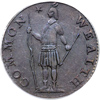 |
1788 Massachusetts Half Cent. PCGS graded AU-55. A scarce issue in high grades, and this one is about average for the grade. The surfaces have no spotting or raised areas, and the color is a touch mottled (PCGS # 308) .
Estimated Value $1,200 - 1,500.
View details and enlarged photos
Check results on similar lots
| Realized
$1,495 |
Lot 20 |
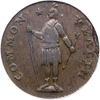 |
1788 Massachusetts Cent. Period after "Massachusetts". PCGS graded VF-30. This example has the open "S"s and was struck at Wetherle's Mint, with dies by Callender (Breen). Medium brown in color and well struck on the devices. We note streaks in the planchet on the obverse, mostly near the right edge, and are not that detracting. A well balanced example of this Important Colonial issue.
Estimated Value $300 - 350.
From the Paul Arthur Norris Collection.
View details and enlarged photos
| Realized
$334 |
Lot 21 |
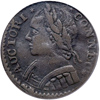 |
1787 Connecticut. Mailed bust facing left. PCGS graded VF-35. A decently struck example without the roughness that is usually encountered. Pleasing medium chocolate brown in color on both sides (PCGS # 349) .
Estimated Value $500 - 600.
View details and enlarged photos
Check results on similar lots
| Unsold |
Lot 22 |
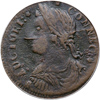 |
1787 Connecticut. Draped bust facing left. PCGS graded VF-25. This one has a strong die break from the second N of CONNEC through the head to the tip of the nose into the field left. Typical dark olive surfaces, with lighter copper tones on the high points. Decently struck given the rather obverse die crack (PCGS # 370) .
Estimated Value $300 - 350.
View details and enlarged photos
Check results on similar lots
| Realized
$253 |
Lot 23 |
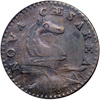 |
1787 New Jersey. Small planchet. PCGS graded AU-55. A nice coin for the grade that has medium brown color and minimal wear on the high points. Unevenly struck from clashed dies, with swelling noted on the obverse around the plow and first two digits of the date. The horse is well formed and has a strong mane. The reverse has a better strike, with sharp devices save for the horizontal lines on the shield. PCGS in their Population Report show 4 graded as AU-55, with 6 above as AU-58 and 3 mint state coins at the top (PCGS # 506) .
Estimated Value $1,100 - 1,300.
View details and enlarged photos
Check results on similar lots
| Realized
$1,208 |
Lot 24 |
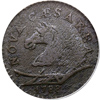 |
1788 New Jersey Copper. Horse's head facing left, Maris 50-F. PCGS graded VF-20. This is one of the scarce Goadsby issues, thought to have been struck very early in 1788. The surfaces are rough, perhaps as much in the original planchet (typical) as from subsequent events. Dark brown in color and pleasing otherwise in appearance. The strike is sharp, and the date is full and complete as this example is unusually well centered. PCGS has graded only 10 of this variety, 9 between the grades of VG-VF, and a single coin higher as EF-45, and the Finest Known mint state Garrett coin apparently hasn't been graded yet.
The horse head facing left are all scarce, with only a couple of die pairings used. Draped in a rich history, all such state coinage is highly collectible, and seldom offered.
Estimated Value $1,500 - 1,750.
From the Paul Arthur Norris Collection.
View details and enlarged photos
| Realized
$1,208 |
Lot 25 |
 |
1786 Vermont. "Vermontensium". Sharpness of Fine but rough. The surfaces are a bit rough, but the devices are quite clear. A medium olive brown in color, with the roughness seen frequently on these early copper coins. Some green and red corrosion in the trees and a small rim clip is noted at 10 o'clock on the obverse.
Estimated Value $400 - 450.
View details and enlarged photos
| Realized
$322 |
Lot 26 |
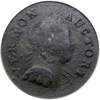 |
1788 Vermont. PCGS graded VF-25. Bust Right. A notorious poorly struck issue, this example however, is far nicer than usually seen. We note some verdigris scattered about, none of which is too serious. A well balanced and decent coin with even dark brown coloration throughout (PCGS # 563) .
Estimated Value $500 - 600.
View details and enlarged photos
Check results on similar lots
| Realized
$477 |
Lot 27 |
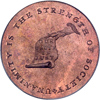 |
(c.1792-94) Kentucky Cent. Lettered edge, "LANCASTER". PCGS graded MS-64 Red. Faded mint color on both sides, with a couple of very minor streaks in the planchet as well. Sharply struck and about as nice as this issue is found. In fact, PCGS has graded 33 as such, with only 6 higher (all MS-65 Red) of this variety. Satiny smooth fields and devices, and well struck throughout.
Estimated Value $1,500 - 2,000.
View details and enlarged photos
| Realized
$1,610 |
Lot 28 |
|
(c.1792-94) Kentucky Cent. Lettered edge, "LANCASTER". Sharpness of Fine but porous. The surfaces are dark olive and porous, and we note some minor rim ticks. Lighter brown on the devices.
Estimated Value $90 - 110.
View details
| Realized
$63 |
Lot 29 |
|
1783 Washington token. Large military bust. Sharpness of Fine Cleaned & Bent. This one has been cleaned and bent, with an attempted punch on the reverse through UNITED STATES, which damages the obverse as well.
Estimated Value $40 - 60.
View details
| Realized
$58 |
Lot 30 |
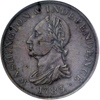 |
1783 Washington token. Draped bust, no button. PCGS graded AU-50. A well struck and problem free example, exhibiting a uniform milk chocolate brown color (PCGS # 676) .
Estimated Value $500 - 600.
View details and enlarged photos
Check results on similar lots
| Realized
$483 |
Lot 31 |
 |
1783 Washington token. "UNITY STATES". PCGS graded AU-53. As often encountered, softly struck up around the borders. The surfaces are nice with a uniform chocolate, slightly reddish-brown patina (PCGS # 689) .
Estimated Value $500 - 600.
View details and enlarged photos
Check results on similar lots
| Realized
$483 |
Lot 32 |
|
(c.1783) Washington Double Head Cent. PCGS graded EF-40. An excellent example for the grade with medium brown color and the surfaces showing only the normal allotment of marks. These apparently were made in Birmingham, and have turned up in non collector accumulations of the period (PCGS # 692) .
Estimated Value $300 - 375.
View details
Check results on similar lots
| Realized
$276 |
Lot 33 |
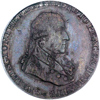 |
1795 Washington Halfpenny. Grate reverse, large buttons, lettered edge. PCGS graded MS-62 Brown. Dark brown in color and with a few minor raised areas. Moderate handling marks and a long thin planchet crack or possibly a scratch above Washington's head. PCGS in their Population Report note 3 graded as such with 4 graded higher in all the color variations of this popular Colonial issue (PCGS # 743) .
Estimated Value $2,500 - 3,000.
View details and enlarged photos
Check results on similar lots
| Unsold |
Lot 34 |
 |
1795 Washington Halfpenny. Grate reverse, large buttons, reeded edge. PCGS graded MS-63 Brown. As always, struck on a slightly too small planchet, so the tops of some letters are missing. Nice medium to dark brown in color, with lighter hues in the devices. Well struck by the dies, and without the usual problems that often plague these early colonial coppers. Ever popular for the Washington motif (PCGS # 746) .
Estimated Value $1,300 - 1,400.
View details and enlarged photos
Check results on similar lots
| Unsold |
Lot 35 |
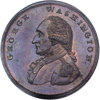 |
(1795) Washington "Liberty and Security" Penny. PCGS graded MS-64 Red & Brown. One of the nicest of these seen by PCGS, which notes 11 graded this high with just 2 higher in MS-65. An impressive coin that boasts mellow red color throughout and a hint of bluish-red around the outer fields. All devices are fully struck, and this coin is far better than most copper coins of the era. Stunning surfaces that show few sings of handling and are totally problem-free. A foremost opportunity for the Colonial period collector.
Estimated Value $2,500 - 3,000.
View details and enlarged photos
| Unsold |
Lot 36 |
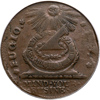 |
1787 Fugio Cent. Pointed rays, cinquefoils, "STATES UNITED". PCGS graded VF-35. Light glossy tan in color and wells struck. There are a few small planchet flakes near the edge, visible with a glass, and the planchet is otherwise smooth and desirable (PCGS # 883) .
Estimated Value $500 - 600.
View details and enlarged photos
Check results on similar lots
| Realized
$604 |
|
|